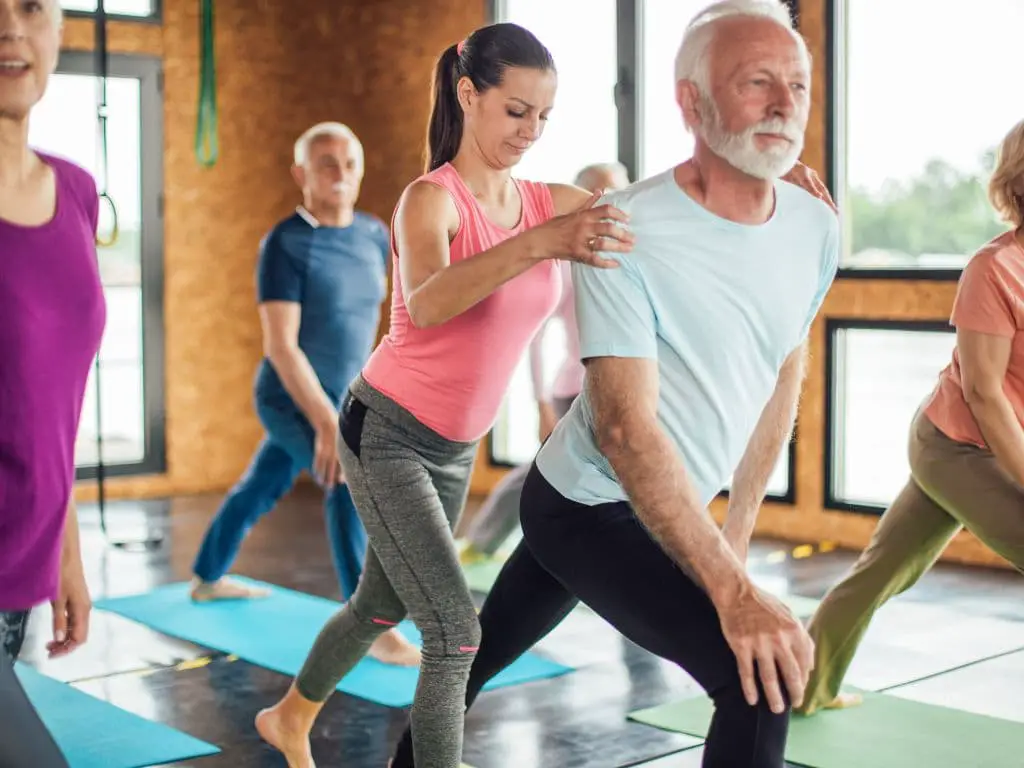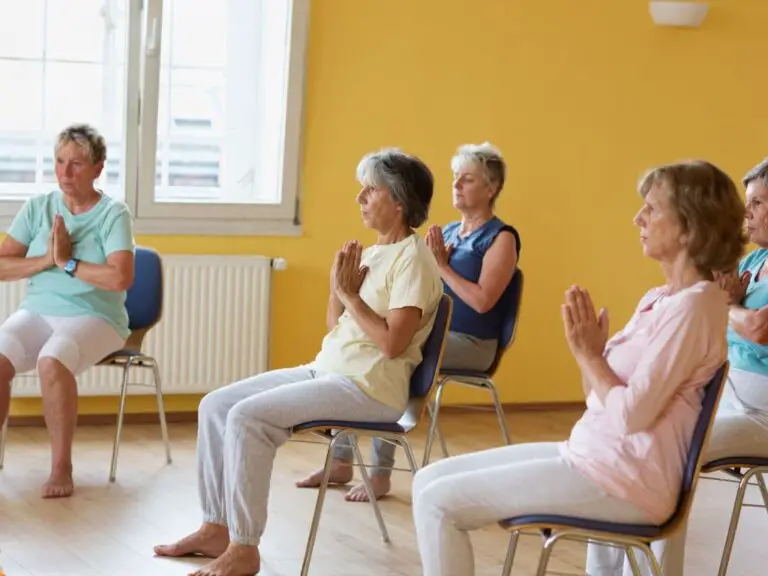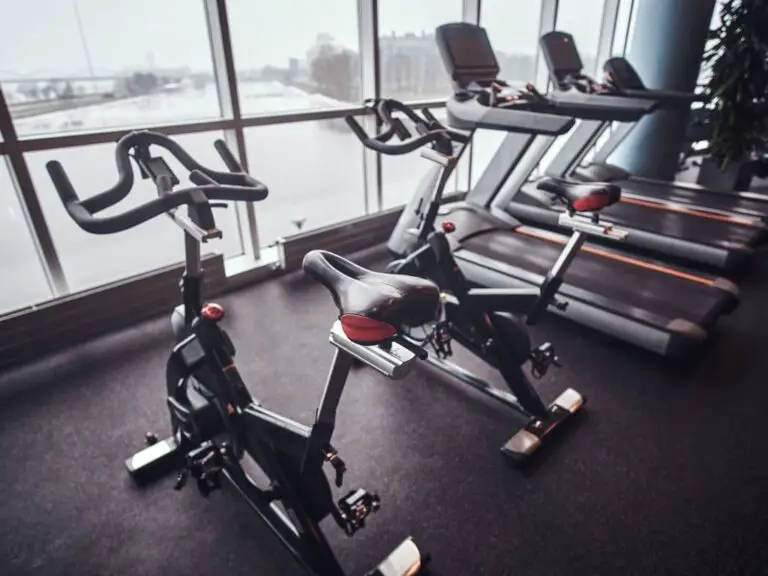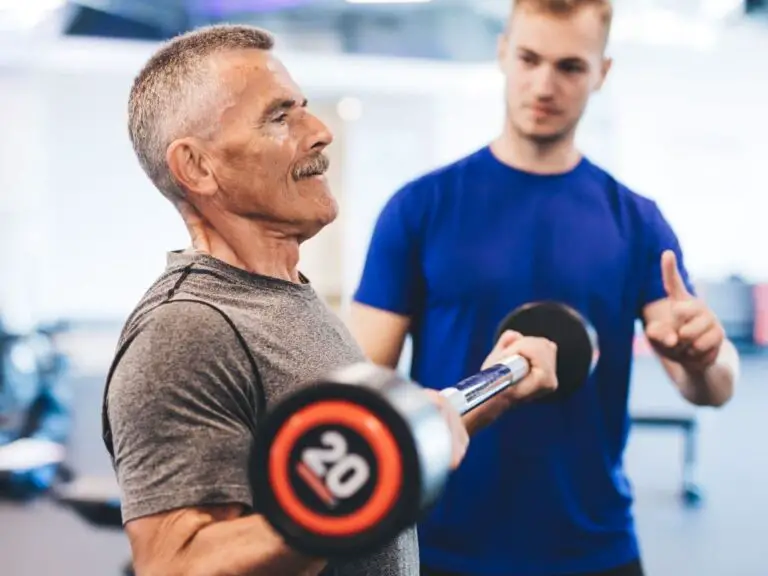Can I Correct My Posture at 60?
It’s never too late to correct your posture, even in your 60s.
Yes, you can correct your posture at 60. Bad posture, caused by conditions like kyphosis, lordosis, scoliosis, or lifestyle factors, can be improved with consistent exercises, stretching, and lifestyle modifications. Activities like yoga, Pilates, and Tai Chi can enhance core strength and flexibility. Regular core strengthening, muscle balance exercises, and maintaining body alignment can help improve posture. For severe cases, professional help like physical therapy, chiropractic adjustments, or surgery may be needed.
With some dedication and consistency, you can absolutely improve your posture and reap the many benefits that come along with it.

What are the Different Types of Bad Posture and Their Causes?
There are several common types of bad posture and various causes that contribute to them:
- Kyphosis – Also called “hunchback”, kyphosis is an excessive curvature of the upper back. It can be caused by aging, osteoporosis, arthritis, or vertebral compression fractures.
- Lordosis – Also known as “swayback”, lordosis is an exaggerated arch in the lower back. Tight hip flexors, weak abdominals, and pregnancy can cause lordosis.
- Scoliosis – Scoliosis causes an abnormal sideways curvature of the spine. While often idiopathic, it can also result from poor posture, muscle spasms, or congenital causes.
- Rounded shoulders – Shoulders that roll forward can be caused by muscle imbalances and weakness, desk work, improper bag carrying, and poor posture habits.
- Forward head posture – Bringing the head forward of the body’s centerline strains the neck and upper back. Long periods of desk work, phone use, and poor posture contribute.
- Flat back – Having no curve in the lower back strains the spine and is linked to weak abdominals, tight hip flexors, and pelvic tilts.
Other causes of bad posture include obesity, pregnancy, high heel shoes, injuries, and medical conditions like disc problems. Understanding what is contributing to your particular postural issues ensures proper treatment and prevention.
There are three main types of bad posture that can affect people as they age:
How Does Kyphosis, Lordosis, and Scoliosis Affect Posture?
- Kyphosis causes an abnormal curve in the spine that leads to a hunchback or rounding of the upper back. This is often called “dowager’s hump.” Kyphosis can be caused by aging, arthritis, osteoporosis, or vertebral compression fractures.
- Lordosis is an exaggerated curve in the lower back. Poor abdominal strength, tight hip flexors, and pregnancy can cause this swayback posture.
- Scoliosis is an abnormal sideways spinal curve. While the cause is often unknown, it can develop from poor posture, uneven pelvis, muscle spasms, or spine problems present at birth.
All three of these spinal curvature conditions negatively impact posture by shifting the alignment and weight-bearing capacity of the back. This strains muscles and ligaments.
What are the Common Causes of Bad Posture?
Some other causes of bad posture include:
- Weak core muscles – Without abdominal strength, the back has to work harder to keep you upright.
- Tight hips – Tight hips and hamstrings can tilt the pelvis forward and strain the lower back.
- Obesity – Excess weight puts pressure on the spine contributing to rounding shoulders and forward head position.
- Pregnancy – Carrying a baby shifts the center of gravity, strains the back, and causes spine curvature.
- High heel shoes – Heels tilt the pelvis forward and compress the spine leading to lordosis.
- Muscle imbalance – When some muscles are much stronger than their opposing muscle groups, it pulls the body out of alignment.
- Poor sitting/standing habits – Slouching, slumped shoulders, and other bad habits distort the natural spinal curves.
What are the Effects of Bad Posture on the Body?
Bad posture can have wide-ranging effects on the body if left uncorrected.
| Effect | Description |
|---|---|
| Back pain | Abnormal spinal curvature and strained muscles/ligaments commonly lead to back pain. Lower back pain can result from pelvic tilts and lordosis. Upper back pain is associated with kyphosis, rounded shoulders, and forward head posture. |
| Neck pain | Forward head carriage causes muscle strain in the neck and upper back. This compression can cause neck pain, stiffness, and headaches. |
| Shoulder pain | Rounded shoulders pull the shoulder joint out of proper alignment, irritating tendons and bursae and leading to pain. |
| Headaches | Forward head posture overstretches the muscles at the back of the neck and shoulders, leading to tension headaches. |
| Breathing issues | Slumped posture compresses the lungs and ribcage, making it harder to take deep, full breaths. Shallow “chest breathing” can reduce energy. |
| Joint degeneration | Poor posture alters the biomechanics of joints like the hips and knees, increasing wear and tear over time. |
| Muscle strain | Postural imbalances force some muscles to overwork while others weaken from underuse. This leads to fatigue and tightness. |
| Pinched nerves | Spinal misalignment from posture problems can stress or compress nerves, causing pain, numbness, and tingling. |
| Fatigue | Poor breathing from slouching reduces oxygen intake, contributing to low energy and fatigue. |
Correcting bad posture is crucial for reducing pain, breathing easier, preventing injury, and avoiding further complications.
How Does Bad Posture Lead to Shoulder, Neck, and Back Pain?
Poor posture typically leads to back pain because it places strain on the spinal ligaments and muscles. Pelvic misalignment due to lordosis or kyphosis can cause lower back pain. Rounded shoulders and forward head posture often result in upper back and neck pain.
Bad posture can also contribute to shoulder pain. As the shoulders roll forward, the shoulder joint is pulled out of alignment. This can compress or irritate shoulder tendons and bursae.
Can Bad Posture Cause Headaches and Fatigue?
Yes, bad posture can result in both headaches and fatigue. Forward head posture stresses the muscles at the back of the neck and shoulders. This can lead to tension headaches. Slumped posture also reduces lung capacity making it harder to take deep breaths. Over time, poor breathing can reduce energy levels.
What are the Benefits of Good Posture?
Maintaining good posture provides a wide range of physical and mental health benefits.
One major benefit is reduced pain and strain. When you consistently maintain proper spinal alignment and posture, it takes pressure off your muscles, joints, and ligaments. Slouching, slumping, and other poor postural habits place these tissues in awkward positions that lead to fatigue and pain over time. By keeping your ears, shoulders, and hips aligned vertically, your frame is balanced and less likely to cause discomfort. Many who put effort into improving posture find their chronic back, neck, and shoulder pain dissipates.
Good posture also enhances your mobility and balance. When your center of gravity is aligned and your weight evenly distributed, you have increased coordination and equilibrium. Movements like bending, reaching, and walking require less exertion and feel more fluid. You’re less likely to experience accidents or falls when your posture is upright and balanced. Proper posture allows you to move efficiently and with stability.
Mentally, good posture can boost self-confidence and energy levels. Standing or sitting tall with your shoulders back demonstrates confidence to others while also making you feel more positive and motivated. Correct posture also enables deeper breathing, increasing oxygen circulation. This gives you greater endurance and focus throughout your day. Overall, the combination of reduced pain, easier mobility, and enhanced mentality that stems from good posture helps sustain an active, healthy lifestyle.
How Does Good Posture Improve Balance and Mobility?
Good posture allows you to balance more easily because your center of gravity is aligned properly over your base of support. Correct spinal curves help you maintain equilibrium through coordinated muscle actions.
Upright posture also increases mobility. When your body is balanced well, it takes less effort to walk, bend, reach overhead, and perform daily activities. Back pain from posture problems can really limit mobility.
Can Good Posture Increase Independence?
Yes, good posture can allow you to remain independent as you age. The ability to move and balance freely helps you continue doing the activities you enjoy. Reduced fatigue and pain enables greater endurance so you can live actively.
How Can I Improve My Posture at Any Age?
It’s never too late to improve your posture through various exercises, lifestyle modifications, and therapies. Here are some tips on how to enhance your posture at any age:
Incorporating specific stretches and strengthening exercises into your daily routine can help retrain your posture. For example, stretches that open the chest and front of the shoulders can counteract hunching. Targeted exercises like yoga, Pilates, and resistance training with bands can strengthen weak postural muscles. A physical or massage therapist can identify problem areas and give exercises tailored to your needs.
Being mindful of daily postural habits is also important. Setting reminders to sit and stand tall, using mirrors to check your alignment, and getting feedback from others will help reinforce good posture. Supportive chairs, orthotics, and back braces can provide external assistance as you retrain your muscles.
Activities like tai chi, swimming, and dance incorporate proper postural alignment in their movements. Pursuing these and other low-impact activities helps ingrain the patterns of good posture. Practices like yoga, Pilates, and Alexander technique also emphasize body awareness that translates to better posture.
For severe postural issues, seeking professional treatment may be warranted. Physical therapists can employ manual techniques and specialized equipment like traction to lengthen tight muscles. Chiropractors realign the joints through adjustments. In serious cases, surgery may be an option to structurally correct scoliosis or kyphosis.
The key is consistency. Be patient and keep practicing good posture until it becomes automatic. Setting aside just 5-10 minutes a day to focus on posture-improving exercises and awareness will pay off over time. Improper posture develops over years, so reversing those habits requires commitment. But with diligence, you can correct your posture at any age.
What Role Does Stretching and Exercise Play in Improving Posture?
Stretching tight muscles and strengthening weak muscles is key to balancing the body for good posture. For example, stretching tight chest muscles allows you to more easily draw the shoulders back. Exercises that strengthen the upper back improve shoulder alignment.
A regular core strengthening routine tones abdominal muscles to support the lower back. Stretches that open the hips and hamstrings help normalize the pelvic tilt.
How Can Yoga, Pilates, and Tai Chi Help Correct Posture?
Yoga, Pilates, and Tai Chi are excellent activities for improving posture through their focus on controlled movements, core strength, flexibility, and breathing.
Yoga standing poses lengthen tight hip flexors and strengthen back muscles. Pilates emphasizes core engagement and alignment. The flowing movements of Tai Chi enhance balance and body awareness.
What are Some Specific Exercises and Stretches That Can Help Improve Posture?
Here are some examples of specific exercises and stretches that can help improve posture:
For the core:
- Planks – Holding the body straight like a plank strengthens the deep core muscles that support the spine.
- Bridge pose – Lying on your back with knees bent, raise your hips up to strengthen your glutes, hamstrings and lower back.
- Bird dog – Get on hands and knees and extend one arm forward and the opposite leg back to improve core stabilization.
For the upper back:
- Shoulder rolls – Rolling the shoulders up and back opens the chest and strengthens the upper back.
- Rows – Use resistance bands or dumbbells to perform upright rows and strengthen the posture muscles between the shoulder blades.
For the hips and legs:
- Hip flexor stretch – Kneel on one knee and press the other hip forward to release tightness in the hips.
- Downward facing dog – This inverted “V” yoga pose stretches the hamstrings, calves, and hip flexors.
- Wide legged forward bend – A standing stretch that lengthens the inner thighs and hips.
For the neck and shoulders:
- Chin tucks – Draw your chin straight back to align your head over the shoulders.
- Chest stretches – Use a doorway or corner to open up the front of the shoulders.
- Neck rotations – Gently rotate the neck in each direction to improve mobility.
Consistently performing these types of exercises and stretches can help rebalance muscles, improve alignment, and ingrain better posture over time. Work with a physical therapist or trainer to design a program tailored to your specific postural issues.
How Can I Strengthen My Core to Improve Posture?
- Planks – Holding the body in a straight line works deep core muscles.
- Bridge pose – Raising the hips tones the glutes, hamstrings, and abs.
- Bird dog – Extending opposite arm and leg improves core stabilization.
What Stretches Can Increase Muscle Flexibility for Better Posture?
- Chest stretches like the door stretch open the front of the shoulders.
- Child’s pose gently lengthens the back muscles.
- Downward facing dog targets tight shoulders, hamstrings, and hips.
- Kneeling hip flexor stretch releases tightness from sitting.
How Can I Maintain Good Posture Throughout the Day?
Maintaining good posture throughout the day requires developing body awareness and making posture a habit through frequent reminders and corrections. Here are some tips:
- Check your alignment often. Set phone reminders to go off periodically so you remember to correct your posture. Use mirrors, windows, or your device camera to check that your head, shoulders, and hips are stacked vertically.
- Be mindful of your posture during daily activities. Make an effort to sit and stand tall. Avoid slouching when using phones, tablets, and computers. Take standing or walking breaks to reset your posture.
- Use props and supports. A lumbar roll or small pillow behind your lower back helps you sit upright. Standing desks and ergonomic chairs facilitate proper alignment.
- Strengthen your core. Having strong abdominal and back muscles enables you to maintain proper posture with less effort. Do core exercises like planks regularly.
- Stretch tight muscle groups. Tight hips, chest, shoulders and lats pull your body out of ideal alignment. Stretch these areas consistently.
- Get feedback from others. Ask family members, friends or colleagues to remind you gently when you slouch. Stay receptive to their feedback.
- Relax your shoulders. Consciously relax your shoulder muscles and keep them down and back. Avoid hunching when sitting or standing.
- Maintain proper neck posture. Be aware of jutting your head forward—keep your eyes level with the horizon.
With consistent reminders, supports and strengthening, good posture can become an automatic habit. Be patient with yourself in the process. In time, the benefits of better alignment and reduced strain will make it second nature.
Making posture a habit requires body awareness and frequent corrections until it becomes second nature.
What is the Importance of Body Alignment in Maintaining Good Posture?
Having proper alignment from head to toe is essential. Get in the habit of visually checking that your ears, shoulders, hips, knees, and ankles are stacked vertically over each other.
Set posture reminders like phone alarms to prompt you to fix your posture throughout the day. Place mirrors to see your posture. Ask friends and family to provide feedback.
How Can I Achieve Pain Relief Through Good Posture?
Consistent good posture can often minimize or eliminate pain caused by poor posture. Allowing the spine to rest in its natural alignment reduces strain and tension. Over time, muscle balance improves and pain subsides.
What is the Role of Physical Therapy and Other Treatments in Correcting Posture?
For moderate or severe postural issues, working with a professional can help.
A physical therapist can assess your posture issues and design a program of stretches, exercises, and manual therapy techniques. They may use massage, joint mobilization, or myofascial release to loosen tight areas. Therapists can also recommend bracing or taping if needed.
What Other Treatments Can Help Improve Posture?
- Chiropractic adjustments can improve spinal alignment and mobility.
- Acupuncture may help reduce muscle tension and pain.
- Assistive devices like back braces, shoe inserts, or taping can provide external postural support.
- Surgery can correct serious cases related to scoliosis or kyphosis.
Conclusion
At any age, improving posture requires awareness and consistency. But it’s one of the most beneficial things you can do for reducing pain, optimizing mobility, and staying active. With some focus on proper alignment, stretches, and strengthening, you can absolutely correct your posture in your 60s and beyond.
Frequently Asked Questions
-
Can I correct my posture at 60?
It’s possible to correct some signs and symptoms associated with poor posture. These exercises will strengthen your spine and should be done at least 3 times per week. Your body will come back to its natural state if you have a good posture.
-
Why do I stoop when I walk?
There are many factors that contribute to the hyperkyphosis (postural stoop) or hyperkyphosis. This refers to the overexaggerated, rounded upper back. They include loss of muscle strength, osteoporosis, and disc degeneration. There are two types of spine: the vertebrae (bones) and discs, which cushion each bone.
-
How long does it take to correct posture?
These exercises can improve your posture. However, Dr. Bang warns that it may take time to develop a good habit. It can take anywhere from four to six weeks for real results, just like any exercise program.
-
What is the fastest way to fix forward head posture?
To keep your head above the spine, chin tucks is a key exercise. Standing with your back straight against the wall, place your feet shoulder width apart. Turn your face forward and tuck you chin to the wall. You can hold the stretch for five seconds, then rest and go back 10 times.
-
Can you correct years of bad posture?
It’s possible for you to improve your posture, even if it has been an issue for many years. You may think your posture is fixed once you reach an age. There’s still a chance that you could stand taller.
-
Can a back hump from osteoporosis be reversed?
Is it possible to reverse the effects of a woman who is a dowager? Dr. Wilson said that depending on the severity of your problem and age, it is possible to often reverse or improve this condition. This can be achieved by strengthening your upper back muscles. Toning up helps to pull the shoulders and head higher.
-
Why do old people have poor posture?
As we age, we experience deterioration in body mechanics due to regressive changes of ligaments and cartilage. Because of a decline in muscle strength, older people subconsciously adjust their spine to balance their weight, which has a significant impact on body posture.
-
Is posture Brace good for elderly?
Braces can be used to reduce neck or shoulder slouching, and prevent injury from poor posture. This posture corrector can provide real-time feedback about your posture and take the strain off of your back, Dr. Singh says.
-
Does walking improve posture?
You can also walk to improve your posture, core recruitment and lower back pain. It is essential to maintain a healthy posture so that you don’t put too much pressure on your joints and muscles.
-
How do you correct posture in the elderly?
Start by standing straight up. Your shoulders should be back, and your head must be raised. Keep elbows close to the sides and bend elbows 90 degrees. Maintaining a good posture, pull your shoulders back and squeeze the shoulder blades together. You may feel a stretch in the chest or front of your shoulder.






